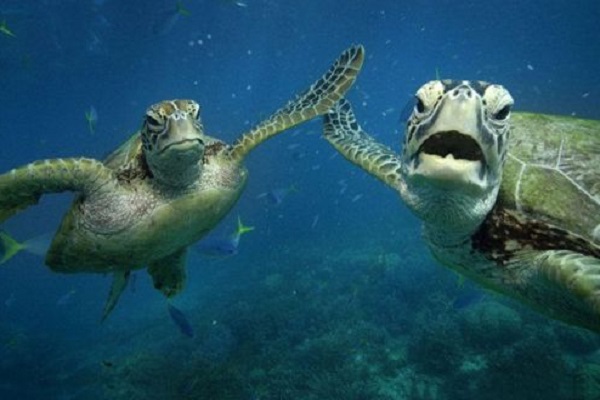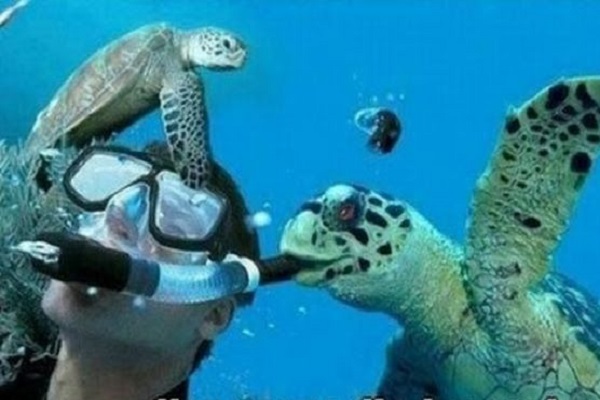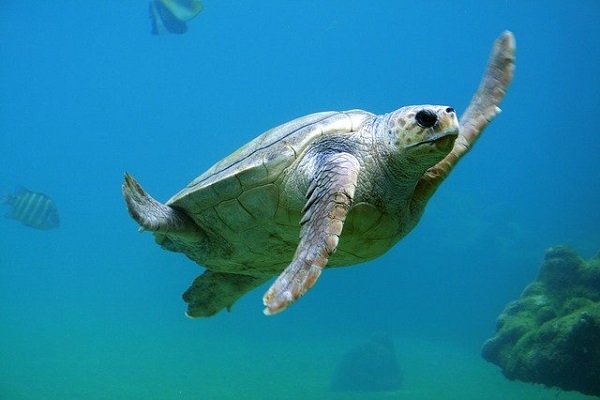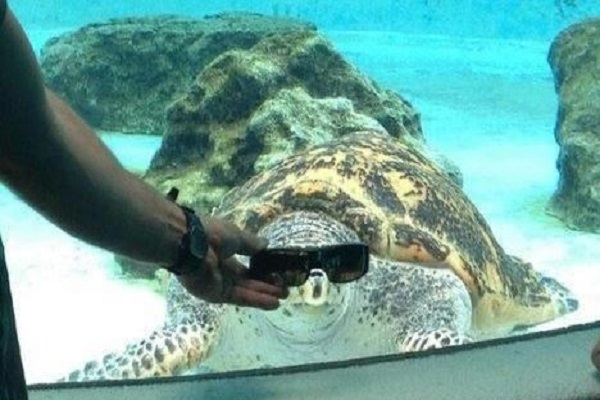Морские черепахи — одно из величайших чудес природы, и люди веками пытаются понять этих древних существ. Они не самые могущественные и не самые красивые, но вид одного из них всегда заставляет людей останавливаться и удивляться. Они существуют дольше, чем люди, но сейчас мы представляем наибольшую угрозу их выживанию. Это не означает, что люди отказались от черепах, во всем мире существует множество проектов по сохранению этих бедных существ. Однако, несмотря на их восхищение, мы еще так много о них не знаем. Вот несколько интересных фактов о морских черепахах, которые вы, вероятно, не знали.

У них есть компас в голове
Черепахи чувствительны к магнитному полю Земли, так как у них есть встроенный GPS благодаря специальным рецепторам, расположенным в их мозгу. Они могут определить свое точное местоположение по отношению к магнитному полю Земли, следовательно, способность находить благоприятные места для кормления и возвращаться обратно в свои родные места гнездования (дом), чтобы откладывать яйца именно в том месте, где они были вылуплены. Эта особая особенность позволяет черепахам мигрировать на тысячи миль и по-прежнему находить места своего гнездования спустя полвека. Это загадка, которую науке еще предстоит полностью понять.

Их пол определяется температурой
Черепахи покидают свои гнезда, как только откладывают яйца, и никогда не видят, как их детеныши насиживают гнездо в одиночестве. Температура гнезда зависит исключительно от температуры окружающего пляжа или земли. При температуре инкубации 87,8 градусов по Фаренгейту вылупившиеся детеныши будут самками, а при температуре 81,86 градусов по Фаренгейту — самцами. В промежутке между ними появятся как самцы, так и самки. Глобальное потепление привело к тому, что вылупившихся самок стало больше, чем самцов, что ставит под угрозу их выживание.

Черепахи могут утонуть
У морских черепах нет жабр. Поэтому так же, как киты и дельфины, им приходится периодически всплывать на поверхность, чтобы подышать воздухом. Несмотря на то, что под водой они могут замедлить частоту сердечных сокращений до 9 раз, что снижает скорость перекачки кислорода в кровь, черепахи могут утонуть, оказавшись в ловушке в рыбьих раковинах, во рту хищника или когда самки перевешивают множество самцов, пытающихся спариться. ее одновременно. Такие заболевания, как папилломавирус, также могут препятствовать их способности выходить на поверхность.

6 из 7 существующих видов морских черепах находятся под угрозой исчезновения.
Из 7 известных видов черепах шесть занесены в список CITIE как уязвимые, находящиеся под угрозой исчезновения и находящиеся под угрозой исчезновения. Зеленая черепаха — единственная растительноядная морская черепаха, отвечающая за контроль над травой, следовательно, за общее здоровье коралловых садов. Они также классифицируются как находящиеся под угрозой исчезновения.
Черепахи бисса имеют блестящий красивый зазубренный панцирь, что делает их мишенью для черного рынка. На них часто охотятся, удаляют панцири, используют для изготовления украшений и гребней. Этот тип черепах уникален и жизненно важен для морского мира, поскольку это единственный вид черепах, который может потреблять токсичные губки и не подвергаться их токсичности. Развитие прибрежных городов и туризм по-разному влияют на количество морских черепах, поскольку увеличивается активность человека как на пляже, так и чрезмерный вылов рыбы для обслуживания растущей отрасли.

Некоторые черепахи могут замерзнуть, не умирая
Когда морские черепахи подвергаются воздействию холодной воды в течение длительного периода времени, они проявляют гипотермическую реакцию, называемую холодным оглушением. Помните, что морские черепахи экзотермичны — они не могут регулировать температуру своего тела, поэтому холодная вода становится опасной.
Несмотря на эту угрозу, есть один вид, называемый западной расписной черепахой, который может замерзнуть, дышать через зад и чрезвычайно замедлять свой метаболизм. В замороженном состоянии черепаха превращается в глыбу льда, которая может разбиться или треснуть, но если ничего из этого не произойдет, все будет в порядке, когда похолодание закончится.

Только 1 из 1000 детенышей выживает
Причина, по которой черепахи откладывают более 100 яиц в одно гнездо и одновременно откладывается довольно большое количество самок, заключается в том, чтобы повысить шансы вылупившихся детенышей на выживание. При успешном гнездовании в месте гнездования тысячи детенышей пробиваются к океану, но сталкиваются с многочисленными хищниками со стороны птиц и бродячих собак на пляже, а также крабов из нор внизу. По оценкам, только 1 из 1000 доживает до зрелого возраста.
Новорожденная черепаха всего 10 см в длину, но обладает большой скоростью и врожденными инстинктами, позволяющими избежать нападения хищников. Даже достигнув океана, эти младенцы всю жизнь мигрируют, сталкиваясь с хищниками, попадая в рыболовные сети и тонув.

Они могут жить больше века
В то время как средняя продолжительность жизни большинства морских черепах составляет 80 лет, некоторые черепахи на самом деле могут жить до 100 лет, а те, которых содержат в качестве домашних животных, даже более века. Их медленный метаболизм и диета из медуз дают им преимущество в более долгой и здоровой жизни. Известно, что черепахи, их наземные родственники, доживают до 150 лет в неволе.

Их панцирь также является их грудной клеткой
Внешний панцирь черепахи состоит из того же материала, что и ногти человека, называемого кератином. Кератин является наиболее распространенной формой белка, встречающейся в живых организмах. Этот твердый панцирь не встречается у видов с мягким панцирем, таких как кожистые черепахи. Внешняя оболочка слита с их грудной клеткой, ребра растянуты, образуя более широкие ребра, чем соединяясь вместе, образуя защитный слой. Нижние ребра соединяются, образуя пластрон, покрывающий черепаху снизу. Каждый рисунок черепашьего панциря и головы уникален для каждого человека, как отпечатки пальцев человека.

Они пережили вымирание динозавров
Они являются одними из старейших видов на планете, примерно того же возраста, что и динозавры. С самыми старыми морскими черепахами, датируемыми 220 миллионами лет назад, эти удивительные существа существовали и пережили массовое вымирание, в результате которого была уничтожена вся популяция динозавров. Их способность питаться, плавать и задерживать дыхание под водой позволила им выжить на протяжении миллионов лет.

Некоторые могут продержаться 30 минут без дыхания
Время, проведенное морскими черепахами под водой, зависит от вида. Было обнаружено, что некоторые из них, такие как морская черепаха логгерхед, проводят под водой более 8 часов. Черепахи способны спать 4-7 часов и до 10 часов в спячке под водой, не тонув. Только когда они попадают в рыболовные сети и другие ловушки, используемые рыбаками, они не могут всплыть на поверхность, чтобы дышать, и умирают, если их не спасти.
📚 Не пропустите интересную информацию:
-
8 скрытых от толп туристов приморских городов в Италии
Среди очаровательных прибрежных городов Средиземноморья выделяются такие популярные направления, как Чинкве-Терре и побережье Амальфи. Эти регионы с их красочными домами, крутыми скалами, исторической атмосферой и... -
7 основных правил, которые следует знать тем, кто хочет следовать средиземноморской диете
Средиземноморская диета — это модель питания, которая предлагает вкусный и здоровый образ жизни. Секрет этой диеты заключается в поддержании баланса путем акцента на свежих и... -
11 плато в Черноморском регионе — кислородный резервуар, где можно в полной мере насладиться природой
Черноморский регион — лучшее место для тех, кто ищет альтернативу отдыху на море, для тех, кто хочет сбежать от городской суеты и тех, кого утомляет... -
10 самых интересных существ, обитающих в морских глубинах
Стремительно развивающиеся технологии позволили нам значительно расширить свои знания о космосе и Вселенной всего за несколько лет. Нам удалось освоить даже мельчайшие подробности о некоторых... -
10 самых смертоносных морских животных в мире
Каким бы безмятежным и привлекательным ни казалось дно океана, вы должны помнить, что эта среда также очень опасна, некоторые из самых смертоносных существ в мире...






